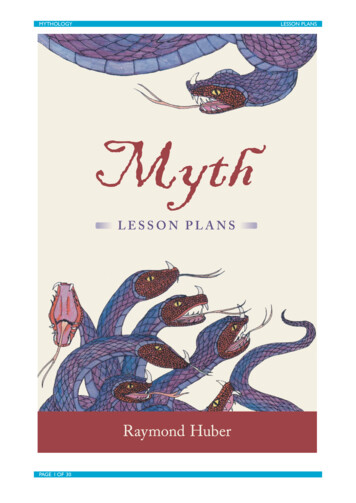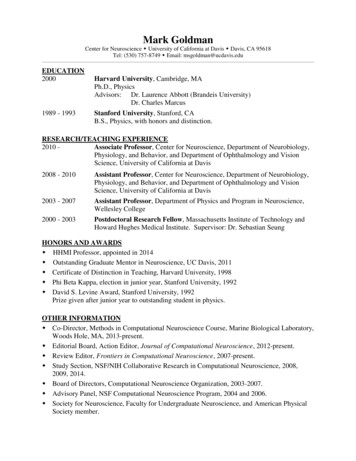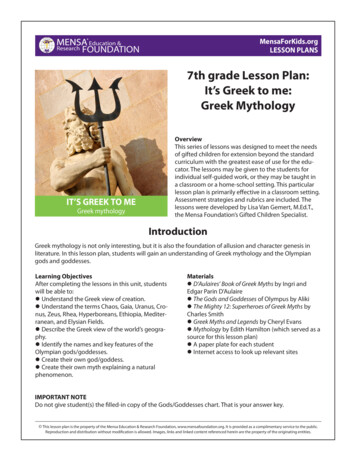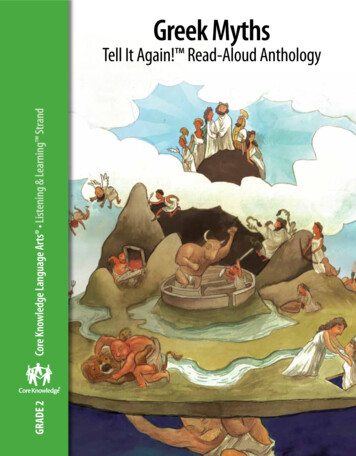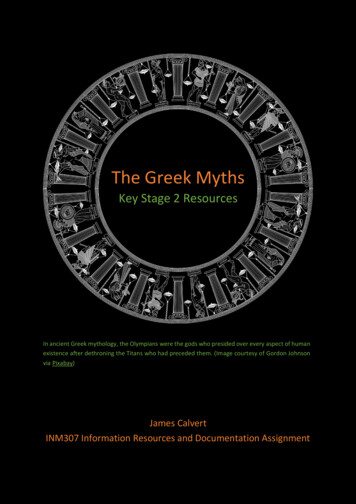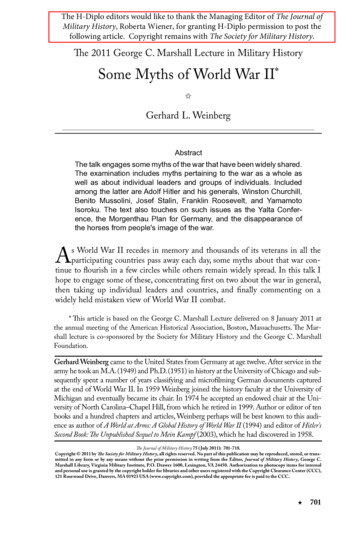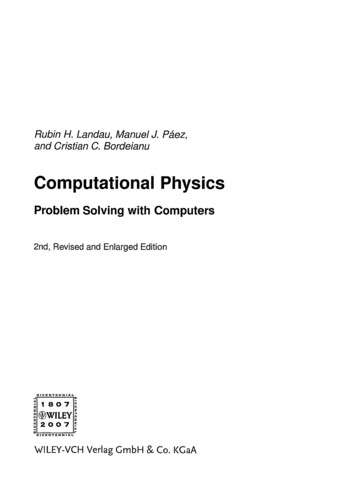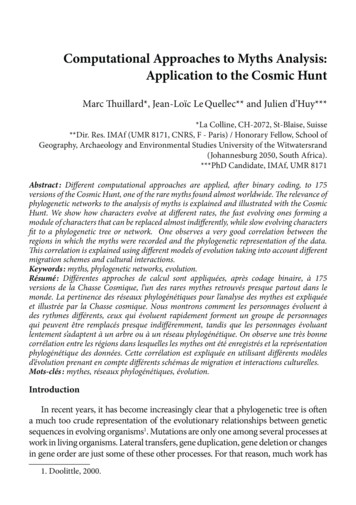
Transcription
Computational Approaches to Myths Analysis:Application to the Cosmic HuntMarc Thuillard*, Jean-Loïc Le Quellec** and Julien d’Huy****La Colline, CH-2072, St-Blaise, Suisse**Dir. Res. IMAf (UMR 8171, CNRS, F - Paris) / Honorary Fellow, School ofGeography, Archaeology and Environmental Studies University of the Witwatersrand(Johannesburg 2050, South Africa).***PhD Candidate, IMAf, UMR 8171Abstract : Different computational approaches are applied, after binary coding, to 175versions of the Cosmic Hunt, one of the rare myths found almost worldwide. The relevance ofphylogenetic networks to the analysis of myths is explained and illustrated with the CosmicHunt. We show how characters evolve at different rates, the fast evolving ones forming amodule of characters that can be replaced almost indifferently, while slow evolving charactersfit to a phylogenetic tree or network. One observes a very good correlation between theregions in which the myths were recorded and the phylogenetic representation of the data.This correlation is explained using different models of evolution taking into account differentmigration schemes and cultural interactions.Keywords : myths, phylogenetic networks, evolution.Résumé : Différentes approches de calcul sont appliquées, après codage binaire, à 175versions de la Chasse Cosmique, l’un des rares mythes retrouvés presque partout dans lemonde. La pertinence des réseaux phylogénétiques pour l’analyse des mythes est expliquéeet illustrée par la Chasse cosmique. Nous montrons comment les personnages évoluent àdes rythmes différents, ceux qui évoluent rapidement forment un groupe de personnagesqui peuvent être remplacés presque indifféremment, tandis que les personnages évoluantlentement s’adaptent à un arbre ou à un réseau phylogénétique. On observe une très bonnecorrélation entre les régions dans lesquelles les mythes ont été enregistrés et la représentationphylogénétique des données. Cette corrélation est expliquée en utilisant différents modèlesd’évolution prenant en compte différents schémas de migration et interactions culturelles.Mots-clés : mythes, réseaux phylogénétiques, évolution.IntroductionIn recent years, it has become increasingly clear that a phylogenetic tree is oftena much too crude representation of the evolutionary relationships between geneticsequences in evolving organisms1. Mutations are only one among several processes atwork in living organisms. Lateral transfers, gene duplication, gene deletion or changesin gene order are just some of these other processes. For that reason, much work has1. Doolittle, 2000.
2Nouvelle Mythologie Comparée – 4 – 2018been invested in the development of phylogenetic networks2. A phylogenetic networkcan be regarded as a generalization of a phylogenetic tree. Among phylogeneticnetworks, the so-called outer planar networks have been intensively used for theircapability to describe evolutionary processes combining mutations with a number oflateral transfers or recombination3. Outer planar networks have been used outside ofgenetics, for example to describe the evolution of galaxies in astrophysics4, languagediversification in linguistics5 or the evolution of myths6.The study of myths using mathematical methods has its roots in theirformalization, allowing a structural analysis. After coding, typically with binarycharacters, the different versions of a myth can be analyzed using mathematicsor computational methods. Fischer was the first who came with the idea ofmathematizing myths and folktales to express the distance between types andversions. This procedure was subsequently developed by Petitot and Maranda7.The study of myths according to biological metaphors also has a long history8.Recently models and software borrowed from genetics have been used to classifyversions of a same myth9, to study the role of geography, linguistic and populationboundaries in myth variations10 as well as to reconstruct first human migrationsand proto-folklore11. Myths are believed to evolve over space and time throughtransformations that may be compared to mutations and lateral transfers ingenetics. A mutation corresponds to a random change of some character states.A set of characters transforming through mutation can be represented exactly bya phylogenetic tree provided a new character state appears only once12. One ofthe goals of this article is to apply computational methods to analyze a myth, theCosmic Hunt, and to discuss the results with some simple models of evolution.Unlike genes, cultural elements can be acquired both from other members ofthe same group of peoples and from outside that group, i.e. they can move from2. Huson, Rupp and Scornavacca, 2010.3. Bryant and Moulton, 2002; Thuillard and Moulton, 2011; Thuillard and FraixBurnet, 2015; Gambette, Berry and Paul, 2012.4. Fraix-Burnet, Thuillard and Chattopadhyay, 2015.5. Forster, Toth and Bandelt, 1998; Atkinson and Gray, 2005; McMahon andMcMahon, 2005.6. d'Huy, 2012a, 2013a, 2013b.7. Lévi-Strauss, 1955; Fischer, 1959; Petitot, 2001; Maranda, 1971, 2001.8. Sydow. 1934; Hafstein, 2001.9. Abler, 1987; Oda, 2001.10. Ross, Greenhill and Atkinson, 2013.11. d'Huy,2012a, b, 2013a, b, 2016.12. Semple and Steel, 2003.
M. Thuillard, J.-L. Le Quellec, J. d’Huy – Computational Approaches to Myths Analysis3people to people without the need for those peoples to be genetically related. Thus,the distribution of cultural elements and genetic markers will not necessarily cooccur across different populations. Transmission may occur within a populationor through cultural interaction between different populations. Myth elementscan be transmitted with possibly some changes (like inversions, removal ofsome parts or creation of new elements) or combine versions of several myths.The differences and similarities between the evolution of genes, languages andcultures have been also thoroughly studied13. The conclusions are that despitethe important differences between genes, languages and cultural traits, similartheories and methods (such as NeighborNet or statistical tests on the influence ofan insulation factor versus geographical proximity) can be applied to all of themseparately. In this paper, we will often use genetic terms or refer to processes knownin biology. A whole discipline in computational science, called soft computing,includes bio-inspired computational methods, such as neural networks or geneticalgorithms, that have found many applications in engineering14. It is in this spiritthat analogies with genetic terms have to be understood.What is essential to know about phylogenetic trees and networks(Outer planar networks)?A phylogenetic tree represents under the form of a tree the relationships betweenone or more populations that are believed to form a unit. This unit is generally calleda taxon. The taxa are characterized by a number of characters that can take severalstates. A binary character has two states (yes/no, present/absent, , or translatedin binary form 0/1) while a multistate character may have several states (blue,green, brown). A phylogenetic tree represents in a coded form the relationshipsbetween taxa based on their states. A phylogenetic tree on multistate characters canbe transformed into a phylogeny on binary characters15. For that reason, we restrictthe discussion to phylogenies on binary characters. A phylogenetic reconstructionmethod is generally used to search for the best tree representation of the data. Thebest tree may be a perfect representation of the characters (in this case, it is calleda perfect tree) but may also sometimes be a very bad representation of the data;therefore, any result must be carefully validated.In order to explain the similarities and differences between phylogenetic treesand phylogenetic networks, one has to understand what is a split and what is a13. Ross, Greenhill and Atkinson, 2013; Korotayev and Khaltourina, 2011.14. Thuillard, 2001.15. Stevens and Gusfield, 2010; Thuillard and Fraix-Burnet, 2015.
4Nouvelle Mythologie Comparée – 4 – 2018circular order of the taxa. Cutting an edge of a tree “splits” the taxa into two subsetsA and B. For each split, there is a character on which each taxon in A has the samestate (for instance 1), while all the taxa in B have the complementary state (0 inthe example). A circular order on a phylogenetic tree corresponds to an indexingof the end nodes according to a circular (clockwise or anti-clockwise) scanning ofthe end nodes. One observes in Figure 1 that along a circular order all ones as wellas all zeros are consecutive. This property is called the circular consecutive-ones’property, a property shared by both perfect trees and phylogenetic networks(or more precisely a special type of phylogenetic networks called outer planarnetworks). Let us note that the idea of ordering taxa defined by binary characters,so that the consecutive-ones’ property are fulfilled, finds its root in the work byFlinders Petrie’s work on seriation16.110split00Figure 1.A split on a tree is defined by two complementary subsets of taxa, the first subset with alltaxa having state 1 on a given character and the complementary subset with all taxa withstate 0 on the same character. A planar representation of the tree is shown with a clockwise(arrows) circular order of the taxa.Outer planar networks17 permit the simultaneous representation of alternativetrees and are thus generalizations of trees. An outer planar network reduces to aphylogenetic tree if the so-called 4-gamete rules are fulfilled by each pair of binarycharacters. The 4-gamete rule states that for each pair of binary characters at leastone of the 4 possible gametes (one gamete among (1,0), (0,1), (1,1) or (0,0)) is16. Petrie, 1899.17. Bryant and Moulton, 2002; Dress and Steel, 1992; Huson and Bryant, 2006.
M. Thuillard, J.-L. Le Quellec, J. d’Huy – Computational Approaches to Myths Analysis5missing (The cladistics formulation is not used in this article and therefore terms likehomoplasy are not employed). We are now ready to explain the differences betweena tree and an outer planar network with the examples of Figure 2 (Below we will useindifferently the term phylogenetic networks or outer planar network despite thatouter planar networks are one among many types of phylogenetic networks).Mammal glandsLay eggsBacteria00Eagle01Mammal gland mmal glandsWingsEagleBoaPhylogenetic treeMammal gland 0A1A2Mammal gland 1LionPlatypusEagleBacteriaMammal gland 0PlatypusEagleLionBacteria‘ Lay eggs ogenetic network(outer planar)B2Figure 2.A1) The character ‘Mammal Glands’ splits the taxa into two complementary subsets; A2)Phylogenetic tree obtained on a set of 3 binary characters;B1) Two splits that are incompatible with a perfect tree description;B2) Outer planar network representing exactly the 2 splits. The 2 characters fulfill thecircular consecutive-ones’ property (but not the 4-gamete rules) and can therefore berepresented by a phylogenetic network.
6Nouvelle Mythologie Comparée – 4 – 2018Figure 2A represents graphically a split between two complementary subsetsconsisting on the one side of the taxa, “Lion” and “Elephant”, two mammalsand on the other side of the taxa, “Eagle” and “Boa”, two non-mammaliananimals. The split is represented by an edge connecting the two complementarysubsets. Adding two other characters, the 4 taxa can be described by a perfectphylogenetic tree. The circular order of the planar tree representation is so thateach character fulfills the circular consecutive-ones’ property on the circularorder (Fig 2A). Figure 2B describes another example using the two characters“Mammal Glands” and “Lay eggs”. There is no phylogenetic tree that describesexactly those relationships. No two splits are compatible with a phylogenetictree, but there is nonetheless a circular order of the 4 taxa with the circularconsecutive-ones’ property fulfilled by all characters18. An important result onphylogenetic networks states that if the circular consecutive-ones’ property isfulfilled by all characters on some circular order then the data can be exactlydescribed by an outer planar network as represented in Fig 2B. In summary, the2 splits in Fig.2B can be exactly described by a phylogenetic network but not bya phylogenetic tree.In genetics, a lateral gene transfer corresponds to the transmission of geneticmaterial between different genomes. Translated into the language of binarycharacters a lateral transfer between taxa corresponds to the replacement of thestate of some characters by the corresponding states from another taxon. If alateral transfer takes place between 2 taxa that are adjacent on a phylogenetictree (i.e. the two taxa are consecutive in a circular order), then the lateraltransfer preserves the circular consecutive-ones’ property and therefore19can be described exactly by an outer planar network. A phylogenetic tree isdefined by its nodes and edges with possibly some weight on the edge. Theyare multiple planar representations of a phylogenetic tree that are completelyequivalent. So, by using the degrees of liberty on the planar representation of aphylogenetic tree, one understands that a tree can accommodate many lateraltransfer and still preserves the circular consecutive-ones’ property on somecircular order of the tree. Figure 3 shows such an example. Using the degrees offreedom on the planar representation of a tree, the tree representation on theleft is transformed into the tree representation on the right. All lateral transfers(arrows) are between adjacent taxa on the circular order and the phylogenetictree can exactly be described after lateral transfer by an outer planar networkon the same circular order.18. Bandelt and Dress, 199219. Thuillard and Fraix-Burnet, 2015.
M. Thuillard, J.-L. Le Quellec, J. d’Huy – Computational Approaches to Myths Analysis6651273542134Figure 3.Two different planar representations of the same tree. The tree representation on the rightis so that lateral transfers (represented by arrows) are only between taxa that are adjacenton the circular order. The tree with the lateral transfers can be represented exactly by anouter planar network.SplitsTree420 is used in this study to reconstruct an outer planar network.In real world applications, it is quite rare that all characters fulfill perfectly thecircular consecutive-ones’ property. Quite often a subset of characters fulfillswell the consecutive-one’s property while some other character states seem quiterandom. In order to find out which characters carry most information, one maycompute to what extent all 1 are consecutive. A measure of the deviation to aperfect outer planar network is given by the so-called contradiction21 taking avalue between 0 and 1 (for a perfect outer planar network the contradiction iszero). Computed on a single binary character, the contradiction is zero if thecircular consecutive-ones’ property is fulfilled on the circular order. This studyuses a contradiction C of the form)with Ci the contradiction taking values between zero (perfect outer planarnetwork and one) on the ith character and S(j) the taxon state at position j on thecircular order.20. Huson and Bryant, 2006.21. Thuillard, 2007; Thuillard and Fraix-Burnet, 2009, 2015.
8Nouvelle Mythologie Comparée – 4 – 2018Analysis of the Correlations between CharactersThe Cosmic Hunt is described as motif F59.2. ‘Pursuit of game leads to upperworld’ in the Motif-index of folk-literature22. More specifically, this is a tale where« certain stars and constellations are interpreted as hunters, their dogs, and gameanimals, killed or pursued.23]» An illustrative example is this very short versionrecorded among the Smith Sound’s Inuit:«A number of dogs were pursuing a bear on the ice. The bear graduallyrose up into the air, as did the dogs, until they reached the sky. Then theywere turned into stars. The bear became a larger star in the center of agroup. The constellation (the Pleiades) is called nanuq, ‘bear’»24.The different versions of this motif are mainly located in Eurasia and NorthAmerica, where it was linked with, but by no means limited to the bear.The association between the Cosmic Hunt and the bear both in Europe andNorth America has been puzzling for a long time. G. Bancroft already wrote in1888 that «It is a curious coincidence, that among the Algonquins of the Atlanticand of the Mississippi, alike among the Narragansetts and the Illinois, theNorth Star was called the Bear.25» Stansbury Hagar wrote: «this legend of thecelestial bear, whose seasonal position eternally corresponds with the featuresof the legend (.) was general from the Point Barrow Eskimo on the north, tothe Pueblo on the south, and, singular as it is that these stars should have beenassociated with the same animal in the Old World and the New before the timeof the first-known inter-communication there seems little doubt of the fact thatthis interpretation was common to both continents.26» He was not the only oneto remark this coincidence. And in 1929, William Tyler Olcott noted that, in thecontext of North American mythology, «by no stretch of the imagination can thefigure of a bear be traced out of the stars in this region, and it is one of the greatmysteries as to how the constellation came to be so named.27» The presence of theCosmic Hunt on both sides of the Bering Strait and the parallel between certainEurasian and Amerindian versions to the tiniest detail suggest a deep historicalconnection, that could be Paleolithic in origin28.22. Thompson, 1989.23. Berezkin, 2005a.24. Kroeber, 1899.25. Bancroft, 1888.26. Hagar, 1900.27. Olcott, 1929.28. Berezkin 2005a, 2012.
M. Thuillard, J.-L. Le Quellec, J. d’Huy – Computational Approaches to Myths Analysis9The widespread diffusion of the Cosmic Hunt makes its study very interesting.Specific details among the Cosmic Hunt versions, such as the association of thehunter’s arrow (or its point) with one of the celestial objects above the Orion’sBelt, or the association of Alcor, a weak star in the handle of the Big Dipper,with a dog or a cooking pot, is too specific to have emerged independently inAsia and in America and points toward historic links between the versions. Themotif was first examined by Yuri Berezkin by using an areological approach29: thediffusion of each variant allowed conclusions to be drawn concerning the pastevolution of the motif. The Russian scholar concluded that the motif emergedin Central Asia; the Orion Belt was seen as three ungulate animals. This variantmay have been brought into America more or less at the same time as the motifof Ursa Major identified with seven men (according to Berezkin, the primacy ofthis variant would be proved by its deeper implantation into inner Asia and innerAmerica). Then a new variant of the Cosmic Hunt interpreting Ursa Major as abear or an ungulate would have emerged first in Eurasia and then brought intoAmerica. Around the end of the Pleistocene times, this version could have beenmainly widespread in Western Eurasia, only reaching Northeast Asia shortlybefore 5000–6000 B.P. borrowed and brought into America by the ancestors ofthe Eskaleut-speaking peoples.More recently, one of us had the idea of using phylogenetic tools to analyzethe same motif30. The results of the statistical analysis of three different databasessuggested an East Asian origin of the tale, in which the Big Dipper could have beenfirst considered as an ungulate pursued by a hunter, such a variant having beendisseminated, more or less altered, in North America at the end of the Paleolithicperiod. The results also suggested that a variant connecting the Cosmic Hunt,Orion and the Pleiades probably began to spread later from Asia; and also, thatthese new variants were brought from Beringia into America spreading as far asSouth America and reaching the northern extremes of North America.Berezkin’s and d’Huy’s models are necessarily based on simplifyingassumptions. They require further refinements and tests to improve theireffectiveness or to be refuted. It is why we reactivate these researches on a newfoundation.In the current paper, mythologies from 1347 populations from all over theworld were examined in order to build a database with the largest possiblenumber of Cosmic Hunt versions: 176 versions were found, from Africa (27),29. Berezkin 2005a, b, 2012.30. d'Huy 2012b, 2013b, 2016.
North-America (67), South and Meso-America (36), Eurasia (40), Oceania (6).Each version was analyzed by using the concepts of “motifemes” and “allomotifs”introduced by A. Dundes in order to identify “empirically observable structuralor emic units”31. For example, “All members of the hunt were transformed intostars” is a “motifeme” where different “motifs” may be used: the game could bea bird or a big mammal, and then an herbivore or a carnivore, etc. Then therecan be one prey, or two, or three and one hunter or more, the latter being ahuman or an animal. By comparing the different versions, one can identify anumber of such “allomotifs” (All ‘allomotifs’ were treated as binary characters.).In our database, 206 allomotifs were identified by this method, and coded on apresence/absence/uncertainty basis (i.e.: 1/0/0.5).The distribution of allomotifs (considered here as “characters”) in the CosmicHunt provides already many clues on how myths may evolve. Figure 4 showsa heat map representing the simultaneous occurrence of two characters afterordering the different characters.One observes in Fig.4-6 three main types of characters:- Characters, such as Orion or Carnivore or Ungulate, that have a highco-occurrence with a large number of other characters. Most charactersdefining the main splits in the tree (or outer planar network) belong tothis category- Clusters of characters in which almost all possible pairs of charactersappear within the cluster. These characters define modules ofinterchangeable characters. Upon further examination, these charactersare generally grouped in the same region of an outer planar network.From the evolutionary perspective, evolution seems to operate on themodule. Within a module, characters seem to evolve so rapidly thatthe phylogenetical signal is lost. A notable exception are the Europeanmyth versions that can be described as a tree with 3 branches when thedifferent clusters of characters are treated as single characters (Fig. 5).- Characters that are quite rare. These characters are often associated to asmall number of versions in a similar cultural environment.- Characters that are not correlated in any particular manner to othercharacters. Such characters are mainly not informative in the context ofa phylogenetical analysis and can safely be removed.31. Dundes, 1962.
M. Thuillard, J.-L. Le Quellec, J. d’Huy – Computational Approaches to Myths Analysis11Figure 4.Heat map representing the number of simultaneous occurrences of two characters (red:high number; grey: low number). The number represent the 206 characters after orderingwith NeighborNet. The algorithm used to generate the heat map has 3 different steps. Instep 1, a distance Di,j is computed for each pair of characters (i , j). The distance is obtainedby computing first the number of co-occurrences of state 1. In step 2, the characters areordered by applying a NeighborNet approach32 on the 206 x 206 distance matrix (-D) witheach entry corresponding to one of the 206 characters. In step 3, the number of occurrencesof pairs of characters with both state ‘1’ is computed and represented using a heat mapbased on the order of the characters found in step 2.32. Bryant and Moulton, 2002; Thuillard, 2007.
12Nouvelle Mythologie Comparée – 4 – 2018Figure 5.Enlargement of part of Fig.4, focused on characters specific to ancient Greece-Rome andFrance-Gascony, Basque, Sicily. The situation is typical of a 3 branches tree relating the twoclusters (Ancient Rome, -Greece) and (France-Gascony, Basque, Sicily).1. Pursuer Sirius is related to Orion (7).2. Circumpolar regions: ‘Game has six legs’ and ‘Milky way pursuer’ track’3-5. Characters specifics to versions found in France-Gascony, Basque, Sicily and in ancientGreece, Rome, share a number of characters (6) but have also two subsets of specificscharacters (3: France-Gascony, Basque, Sicily; 5 without 6: Ancient Greece, Rome).3. Populations having domestic animals and possibly involved in cattle raids4. Populations having domestic animals (3) and ‘pursuer wants revenge’ (8)5. Divinity and sexual tabooSome characters are correlated for obvious reasons, as for instance thecharacters Game Herbivore and Game Ungulate. Some correlations are quiteinformative. The hunt of a carnivore is always associated to at least 3 hunters (Fig.6), while the number of hunters varies when the game is an herbivore!
M. Thuillard, J.-L. Le Quellec, J. d’Huy – Computational Approaches to Myths Analysis13Figure 6.Enlargement of part of Fig.4 that shows some interesting correlations.1. Circumpolar regions. Correlation between ‘Milky way pursuer’ track’ and (2), (3).2. ‘Game ungulate’. ‘Persuer(s) man or men’3. ‘Nb of prey 1’Phylogenetic Classification of Myth VersionsFigure 7 shows the outer planar network obtained after iterative applicationof NeighborNet33. The distance between 2 taxa is obtained by summing over allcharacters the differences in state value. The algorithm starts with all characters.At each iteration, the characters with a relative contradiction value34 below a given33. Bryant and Moulton, 2002.34. Thuillard, 2007; Thuillard and Fraix-Burnet, 2009
14Nouvelle Mythologie Comparée – 4 – 2018threshold are selected. The threshold is lowered at each iteration thus eliminatingmore characters at each iteration. With this approach, one selects charactersthat are well described by an outer planar network or a tree and eliminates noninformative characters.Game HerbivoreGame Orion, Herbivore(all regions)Game Bird, ratite, Raedae(South America, Oceania x 3)Game Bear(North America, Ancient Greece, Rome)Game Ursa major1Figure 7.Figure 7 shows the character states on all taxa and characters using the circular orderof the taxa on the x-axis and the different characters on the y-axis after clustering thecharacters using NeighborNet in the character space. The position of the first taxa isindicated by a ‘1’ and the one uses a clockwise (arrow) circular order (Taxa list in annex).One observes that the resulting outer planar network can be approximatedas a phylogenetic tree with 4 main branches. One branch groups North
M. Thuillard, J.-L. Le Quellec, J. d’Huy – Computational Approaches to Myths Analysis15American versions of the myth with the main defining character Game UrsaMajor often together with Game Bear while a second branch contains mostlySouth American versions in connection to a ratite or another bird and/orGame Southern Cross. A third cluster contains myths versions involving mostlyOrion and the character Game Herbivore. The last cluster is characterized byGame Herbivore. In summary, one observes 4 main clusters together withsome clusters in the intermediary region between the main splits, that are moredifficult to precisely characterize. The main splits define a tree to a good level ofapproximation (The 4-gamete rules are fulfilled by the characters defining themain splits).One finds out that actually a small number of characters defines alone the mainsplits in the tree. Restricted to the character Game Ursa Major, one observes avery good correlation between the different continents and the order of the taxaon the outer planar network. The correlation is less marked for Game Orion.The interpretation of the results is not quite straightforward. Let us give someexamples showing the difficulties. One observes 2 clusters within North Americain relation to the presence or absence of Ursa Major Game. In the absence of amodel, one cannot interpret the split between the two subsets of characters asit may as well be the result of a single appearance of a character or the result ofstochastic events leading to the loss of a character. More information is necessaryto decide between the two interpretations. Similarly, one would like to find outhow the transformation between the Game Ursa Major and the Game Orionversions of the myths did happen. The connection between the two versions isdone by the character Game Herbivore. From the point of view of a phylogeneticaldescription, having a split described by a single character is perfectly fine.Nevertheless, one would be interested in finding elements indicating how thetransition did took place. Let us discuss 2 possible mechanisms of transition(known in genetics) that would also favor a complete transformation of the mythkeeping only a few of its characters. Following the thought of Eldredge and Gould35, evolution may proceedrapidly during short periods following a dramatic destruction of a large partof the taxa leaving possibilities for species surviving the extension and adaptedto the new eco-system to strive. Such evolution may be transferred to thestudy of myths36. For instance, let us imagine some populations, possibly onsome strong evolutionary pressure, in which simplified versions of a myth dosurvive. At this stage the myth may revitalize for some reasons and becomes35. Gould, 1972.36. Sydow, 1934; Lévi-Strauss, 1974; d'Huy, 2013b, c.
Nouvelle Mythologie Comparée – 4 – 201816what C. von Sydow calls an ecotype37. The hypothesis is plausible to explainthe transition from the main characters Ursa Major and Herbivore to UrsaMajor and Carnivore during the passage to America of a small migratingpopulation. In biology, the creation of a new gene may occur through gene duplication.After gene doubling, the main biological function is often fulfilled by one copyof the gene, while the second gene is free to evolv
Keywords : myths, phylogenetic networks, evolution. Résumé : Différentes approches de calcul sont appliquées, après codage binaire, à 175 versions de la Chasse Cosmique, l'un des rares mythes retrouvés presque partout dans le monde. La pertinence des réseaux phylogénétiques pour l'analyse des mythes est expliquée
